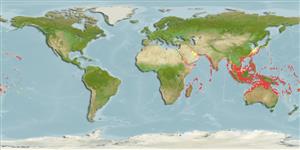Common names from other countries
>
Eupercaria/misc (Various families in series Eupercaria) >
Lutjanidae (Snappers) > Lutjaninae
Etymology: Macolor: Latin, macula, -ae = stain, spot.
More on author: Forsskål.
Environment: milieu / climate zone / depth range / distribution range
Ecologie
marien rifbewoner; diepte 2 - 90 m (Ref. 9821). Tropical; 36°N - 30°S, 31°E - 153°W (Ref. 55)
Indo-Pacific: East Africa to Samoa, north to central Japan, south to Australia.
Grootte / Gewicht / Leeftijd
Maturity: Lm ? range ? - ? cm
Max length : 75.0 cm TL mannelijk / geslacht onbekend; (Ref. 5484); common length : 35.0 cm TL mannelijk / geslacht onbekend; (Ref. 30573)
Dorsale stekels (totaal): 10; Dorsale zachte stralen (totaal): 13-15; Anale stekels 3; Anale zachte stralen: 10 - 11. This species is distinguished by the following characters: body relatively deep and laterally compressed, greatest body depth 2.2-2.4 in SL; dorsal profile of head convex in adults, in oblique straight line in young; maxilla without scales or longitudinal ridges; preopercle with a deep notch (or gash) receiving elongate interopercular spine (none for individuals less than 16 cm SL); gill rakers of first gill arch 26-38 + 60-71 = 89-107; soft rays of dorsal fin usually 14, in anal fin 11, in pectoral fin 17; continuous dorsal fin with spinous portion distinctly notched in young; dorsal and anal fins distinctly pointed posteriorly, the soft ray of both fins, shorter than next to last ray; caudal fin rounded with middle rays elongated in small juveniles, slightly notched at intermediate sizes and emarginate in adults; pelvic fins short and rounded for all sizes; soft dorsal and anal fins with scales basally; tubed lateral-line scales 50-55; juveniles with very long pelvic fins. Colour of adults silvery grey, strongly blotched with blackish patches, lacks yellow on head and body and without blue markings on head and body, much duller iris; juveniles with black and white pattern but broader white area encompassing posterior head and adjacent body and with less than 5 white spots on back (Ref 9821, 90102).
Adults are found on steep outer walls of lagoon, channel and seaward slopes in large schools (Ref. 9710, 48635). Juveniles are solitary (Ref. 30573). Feeds largely on fishes and crustaceans Caught with handlines, gill nets, and traps, but also speared by divers and are frequently seen in markets and sold mainly fresh (Ref. 9821).
Levenscyclus en paargedrag
Maturiteit | Voortplanting | Paaien | Eieren | Fecunditeit | Larven
Allen, G.R., 1985. FAO Species Catalogue. Vol. 6. Snappers of the world. An annotated and illustrated catalogue of lutjanid species known to date. FAO Fish. Synop. 125(6):208 p. Rome: FAO. (Ref. 55)
Status op de Rode Lijst van het IUCN (Ref. 130435)
CITES (Ref. 128078)
Not Evaluated
Gevaar voor de mens
Harmless
Gebruik door de mens
Visserij: commercieel; sportvis: ja; Aquarium: Commercieel
Meer informatie
Lokale namenSynoniemenMetabolismePredatorenEcotoxicologieVoortplantingMaturiteitPaaienFecunditeitEierenOntwikkeling van de eieren
ReferentiesAquacultuurAquacultuurprofielKweeklijnenGeneticaElectrophoresesErfelijkheidZiektesVerwerkingMassaconversie
Tools
Speciale rapporten
Download XML
Internetbronnen
Estimates based on models
Preferred temperature (Ref.
115969): 24.7 - 29.1, mean 28.1 (based on 1828 cells).
Fylogenetische diversiteitsindex (Ref.
82804): PD
50 = 0.7500 [Uniqueness, from 0.5 = low to 2.0 = high].
Bayesian length-weight: a=0.01585 (0.00978 - 0.02569), b=2.99 (2.86 - 3.12), in cm Total Length, based on LWR estimates for this species & (Sub)family-body (Ref.
93245).
Trofisch niveau (Ref.
69278): 4.0 ±0.66 se; based on food items.
Weerstandsvermogen (Ref.
120179): Gemiddeld, minimale populatieverdubbelingstijd 1,4-4,4 jaar (Preliminary K or Fecundity.).
Fishing Vulnerability (Ref.
59153): Moderate to high vulnerability (50 of 100).
